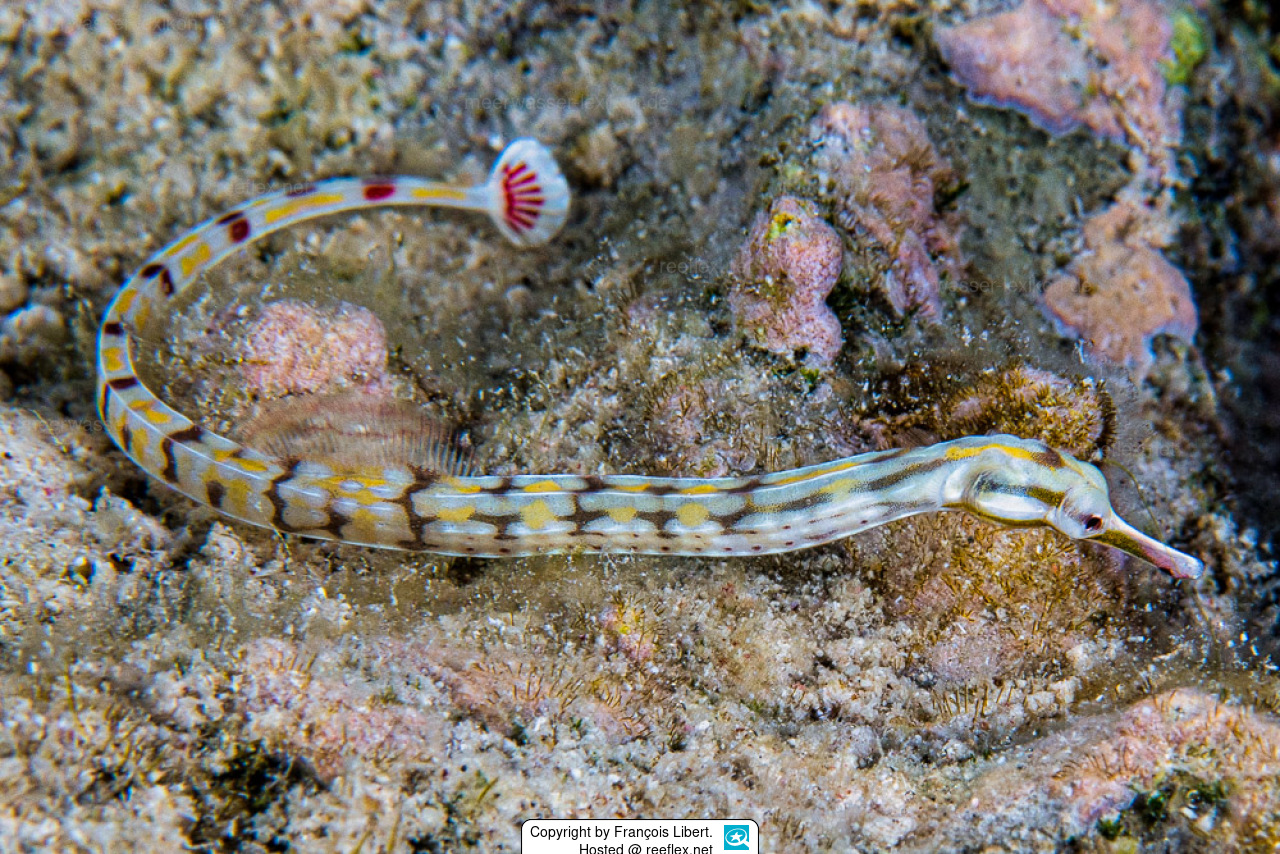Info
For the sea needle Corythoichthys flavofasciatus there is no scientific first description, maybe this is also a reason why there is sometimes a confusion in naming and / or confusion e.g. with Corythoichthys conspicillatus?
Fittingly, the Australian seahorse expert Rudie H. Kuiter wrote: " Occurrence; Red Sea, Indian Ocean. Further evidence is based on other species"
Source (Seahorses, pipefishes, ragfishes and their relatives (2000).
Corythoichthys flavofasciatus is observed in its range among algae-covered rocks and on live coral in lagoons and in seaward reefs, from low tide to high tide line.
Because pipefishes have very small mouths, they can only prey on and eat very small zooplankton such as copepods and invertebrates.
Male pipefish carry the fertilized eggs in a brood pouch located under the tail and release the then fully developed small larvae into the ocean in a short time.
The Yellow-banded pipefish is not specifically targeted in specialized trade, so there is a lack of husbandry experience so far.
It is interesting that there are photos with continuous yellow and with interrupted yellow lines.
Synonyms:
Corithoichthys flavofasciatus (Rüppell, 1838)
Corythiochthys flavofasciatus (Rüppell, 1838)
Corythoichthys fasciatus (Gray, 1830)
Corythoichthys flavo-fasciatus (Rüppell, 1838)
Corythoichthys sealei Jordan & Starks, 1906
Corythoichthys serrulifer Fowler, 1938
Corythroichthys sealei Jordan & Starks, 1906
Syngnathus flavofasciatus Rüppell, 1838
Feeding intake.
The fish take a long time to eat at the beginning, before the food is taken up, a close inspection is carried out. After acclimatisation, the offered frozen food is eaten without problems. It should be noted that wild-caught fish behave differently than offspring when it comes to food intake. In the case of offspring, the size of the fish purchased also plays a role in the choice of food.
Fittingly, the Australian seahorse expert Rudie H. Kuiter wrote: " Occurrence; Red Sea, Indian Ocean. Further evidence is based on other species"
Source (Seahorses, pipefishes, ragfishes and their relatives (2000).
Corythoichthys flavofasciatus is observed in its range among algae-covered rocks and on live coral in lagoons and in seaward reefs, from low tide to high tide line.
Because pipefishes have very small mouths, they can only prey on and eat very small zooplankton such as copepods and invertebrates.
Male pipefish carry the fertilized eggs in a brood pouch located under the tail and release the then fully developed small larvae into the ocean in a short time.
The Yellow-banded pipefish is not specifically targeted in specialized trade, so there is a lack of husbandry experience so far.
It is interesting that there are photos with continuous yellow and with interrupted yellow lines.
Synonyms:
Corithoichthys flavofasciatus (Rüppell, 1838)
Corythiochthys flavofasciatus (Rüppell, 1838)
Corythoichthys fasciatus (Gray, 1830)
Corythoichthys flavo-fasciatus (Rüppell, 1838)
Corythoichthys sealei Jordan & Starks, 1906
Corythoichthys serrulifer Fowler, 1938
Corythroichthys sealei Jordan & Starks, 1906
Syngnathus flavofasciatus Rüppell, 1838
Feeding intake.
The fish take a long time to eat at the beginning, before the food is taken up, a close inspection is carried out. After acclimatisation, the offered frozen food is eaten without problems. It should be noted that wild-caught fish behave differently than offspring when it comes to food intake. In the case of offspring, the size of the fish purchased also plays a role in the choice of food.







 François Libert, Frankreich
François Libert, Frankreich




















